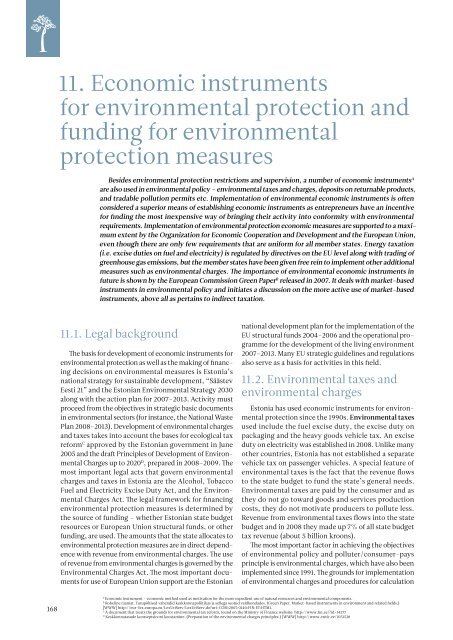ESTONIAN ENVIRONMENTAL REVIEW 2009
ESTONIAN ENVIRONMENTAL REVIEW 2009
ESTONIAN ENVIRONMENTAL REVIEW 2009
Create successful ePaper yourself
Turn your PDF publications into a flip-book with our unique Google optimized e-Paper software.
11. Economic instruments<br />
for environmental protection and<br />
funding for environmental<br />
protection measures<br />
Besides environmental protection restrictions and supervision, a number of economic instruments A<br />
are also used in environmental policy – environmental taxes and charges, deposits on returnable products,<br />
and tradable pollution permits etc. Implementation of environmental economic instruments is often<br />
considered a superior means of establishing economic instruments as entrepreneurs have an incentive<br />
for finding the most inexpensive way of bringing their activity into conformity with environmental<br />
requirements. Implementation of environmental protection economic measures are supported to a maximum<br />
extent by the Organization for Economic Cooperation and Development and the European Union,<br />
even though there are only few requirements that are uniform for all member states. Energy taxation<br />
(i.e. excise duties on fuel and electricity) is regulated by directives on the EU level along with trading of<br />
greenhouse gas emissions, but the member states have been given free rein to implement other additional<br />
measures such as environmental charges. The importance of environmental economic instruments in<br />
future is shown by the European Commission Green Paper B released in 2007. It deals with market-based<br />
instruments in environmental policy and initiates a discussion on the more active use of market-based<br />
instruments, above all as pertains to indirect taxation.<br />
11.1. Legal background<br />
The basis for development of economic instruments for<br />
environmental protection as well as the making of financing<br />
decisions on environmental measures is Estonia’s<br />
national strategy for sustainable development, “Säästev<br />
Eesti 21” and the Estonian Environmental Strategy 2030<br />
along with the action plan for 2007–2013. Activity must<br />
proceed from the objectives in strategic basic documents<br />
in environmental sectors (for instance, the National Waste<br />
Plan 2008–2013). Development of environmental charges<br />
and taxes takes into account the bases for ecological tax<br />
reform C approved by the Estonian government in June<br />
2005 and the draft Principles of Development of Environmental<br />
Charges up to 2020 D , prepared in 2008–<strong>2009</strong>. The<br />
most important legal acts that govern environmental<br />
charges and taxes in Estonia are the Alcohol, Tobacco<br />
Fuel and Electricity Excise Duty Act, and the Environmental<br />
Charges Act. The legal framework for financing<br />
environmental protection measures is determined by<br />
the source of funding – whether Estonian state budget<br />
resources or European Union structural funds, or other<br />
funding, are used. The amounts that the state allocates to<br />
environmental protection measures are in direct dependence<br />
with revenue from environmental charges. The use<br />
of revenue from environmental charges is governed by the<br />
Environmental Charges Act. The most important documents<br />
for use of European Union support are the Estonian<br />
national development plan for the implementation of the<br />
EU structural funds 2004–2006 and the operational programme<br />
for the development of the living environment<br />
2007–2013. Many EU strategic guidelines and regulations<br />
also serve as a basis for activities in this field.<br />
11.2. Environmental taxes and<br />
environmental charges<br />
Estonia has used economic instruments for environmental<br />
protection since the 1990s. Environmental taxes<br />
used include the fuel excise duty, the excise duty on<br />
packaging and the heavy goods vehicle tax. An excise<br />
duty on electricity was established in 2008. Unlike many<br />
other countries, Estonia has not established a separate<br />
vehicle tax on passenger vehicles. A special feature of<br />
environmental taxes is the fact that the revenue flows<br />
to the state budget to fund the state’s general needs.<br />
Environmental taxes are paid by the consumer and as<br />
they do not go toward goods and services production<br />
costs, they do not motivate producers to pollute less.<br />
Revenue from environmental taxes flows into the state<br />
budget and in 2008 they made up 7% of all state budget<br />
tax revenue (about 5 billion kroons).<br />
The most important factor in achieving the objectives<br />
of environmental policy and polluter/consumer-pays<br />
principle is environmental charges, which have also been<br />
implemented since 1991. The grounds for implementation<br />
of environmental charges and procedures for calculation<br />
168<br />
A<br />
Economic instrument – economic method used as motivation for the more expedient use of natural resources and environmental components.<br />
B<br />
Roheline raamat. Turupõhised vahendid keskkonnapoliitikas ja sellega seotud valdkondades. (Green Paper. Market-based instruments in environment and related fields.)<br />
[WWW] http://eur-lex.europa.eu/LexUriServ/LexUriServ.do?uri=COM:2007:0140:FIN:ET:HTML<br />
C<br />
A document that treats the grounds for environmental tax reform, found on the Ministry of Finance website: http://www.fin.ee/?id=14277<br />
D<br />
Keskkonnatasude kontseptsiooni koostamine. (Preparation of the environmental charges principles.) [WWW] http://www.envir.ee/1051528

















